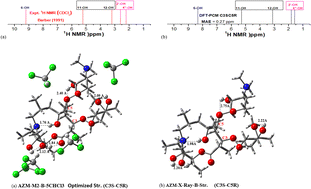An investigation of the predominant structure of antibiotic azithromycin in chloroform solution through NMR and thermodynamic analysis†
Abstract
Azithromycin (AZM) is a well-known macrolide-type antibiotic that has been used in the treatment of infections and inflammations. Knowledge of the predominant molecular structure in solution is a prerequisite for an understanding of the interactions of the drug in biological media. Experimental structural determination can be carried out for samples in solid-state (X-ray diffraction technique) and gas phase (electron diffraction experiment). In solution, spectroscopic methods can be used to extract valuable information which combined with quantum chemical calculations can lead to the determination of the preferred molecular structures to be observed when a given solute is dissolved in each solvent. That is precisely the aim of this work. We used experimental NMR chemical shift data (in CDCl3) as a reference for comparison with Density Functional Theory (DFT) NMR calculations, with geometry optimized having as guess input two crystallographic structures available in the literature with the configuration of all chiral carbon atoms inverted, named here A and B. The Polarizable Continuum Model (PCM) was used to describe the solvent effects (chloroform) including five explicit CHCl3 solvent molecules, which we believe can account for short and long-range solute–solvent interactions. Analysis of calculated thermodynamic, NMR chemical shift, MAE (Mean Absolute Error), and spin–spin coupling constant values revealed that both supposable C3R-C5S (named M2-A) and C3S-C5R (named M2-B) structures are equally probable to exist in chloroform solution. In addition, we found that the heavy atoms’ conformation is reasonably similar in the solid-state and chloroform solution; however, regarding the OH groups, the spatial orientations are rather different with intramolecular OH⋯N and OH⋯O hydrogen bonds present in solution and with some of them being absent in the X-ray structure probably due to crystal packing effects.



 Please wait while we load your content...
Please wait while we load your content...